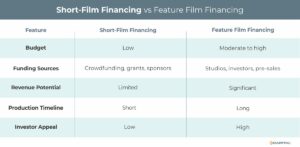
Short-Film Financing: Securing Funds to Bring Your Creative Vision to Life
Content
- What Is Short-Film Financing?
- Why Financing Matters for Short Films
- Methods of Short-Film Financing
- Who Can Benefit from Short-Film Financing?
- Benefits of Short-Film Financing
- Challenges of Short-Film Financing
- Real-World Example: Short-Film Financing in Action
- How to Maximize a Short-Film Budget
- Tips for Successful Short-Film Financing
- Conclusion
- Key Takeaways
Short films hold a crucial place in our culture by offering diverse voices and innovative artistic expressions. They serve as a vital tool for social commentary, cultural representation, and creative exploration, while providing a platform for emerging filmmakers. Whether they are addressing societal issues, preserving cultural heritage, or pushing the boundaries of film as an art form, short films remain an essential and influential aspect of cultural production worldwide.
Short films have long been a proving ground for filmmakers to hone their craft, tell impactful stories, and showcase their creativity. These productions are often independent films (indie-films) with limited resources. Despite their shorter runtime, these films require careful planning and adequate funding to bring a vision to life.
Short-film financing is the critical process of securing the resources needed to cover the five stages of production, from development to distribution. This blog explores the unique challenges and opportunities of financing short films, the methods filmmakers can use to raise funds, and how to maximize the impact of a short-film budget.
What Is Short-Film Financing?
Short-film financing is a type of business financing used to provide the funds necessary to produce a short film, typically ranging from 2 to 40 minutes in length. While short films generally have smaller budgets than feature films, the need for reliable cash flow to acquire professional equipment, skilled crew, and high-quality post-production remains the same.
Key Features of Short-Film Financing:
- Low-Budget Focus: Emphasis on cost-effective production strategies.
- Creative Vision: Financing often hinges on the filmmaker’s unique vision and storytelling potential.
- Diverse Funding Sources: Includes grants, crowdfunding, and sponsorships.
Why Financing Matters for Short Films
While some short films are produced on shoestring budgets or with volunteer efforts, proper financing allows filmmakers to retain the trust of stakeholders and maximize opportunities to:
- Elevate Production Quality: Invest in better equipment, locations, and talent.
- Expand Creative Freedom: Execute ambitious ideas without being constrained by limited resources.
- Reach Broader Audiences: Cover marketing and distribution costs to showcase the film at festivals or online platforms.
Methods of Short-Film Financing
- Crowdfunding
- Filmmakers can gather small contributions from a large audience through networking, special events, and online platforms.
- Film Grants
- Organizations, film commissions, and nonprofits offer grants to support short-film projects, especially those with cultural, educational, or artistic value.
- Personal Savings
- Many filmmakers start by investing their own money or pooling resources with collaborators.
- Sponsorships
- Partnering with brands or local businesses that align with the film’s theme can provide financial or in-kind support.
- Competitions
- Entering pitch contests or development labs can secure funding and mentorship opportunities.
- Partnerships with Schools or Institutions
- Collaborating with film schools or community organizations can provide access to resources, including equipment and crew.
- Revenue Sharing
- Offering investors or collaborators a share of potential festival prizes, licensing deals, or online monetization.
Who Can Benefit from Short-Film Financing?
Short-film financing is essential for:
- Aspiring Filmmakers: Creating portfolio pieces to break into the industry.
- Students: Producing high-quality graduation projects.
- Independent Filmmakers: Experimenting with new ideas or styles.
- Established Directors: Using short films as proof-of-concept projects for larger productions.
Benefits of Short-Film Financing
- Professional Production Standards
- Access to financing ensures the film meets industry standards for cinematography, sound, and editing.
- Broader Reach
- Well-funded films can afford festival submissions, marketing, and distribution to reach global audiences.
- Networking Opportunities
- Financing often involves engaging with industry professionals, fostering valuable connections.
- Proof of Concept
- A professionally produced short film can attract investors or studios for larger projects.
- Creative Fulfillment
- Adequate resources allow filmmakers to fully realize their creative vision.
Challenges of Short-Film Financing
- Limited Budget
- Even with financing, short films often operate on tight budgets, requiring careful prioritization of expenses.
- Securing Funds
- Convincing backers to invest in a non-commercial, low-return project can be difficult.
- Competition for Grants
- Film grants are highly competitive and often require extensive applications.
- Time Constraints
- Crowdfunding campaigns and sponsorship negotiations can delay production timelines.
- Revenue Generation
- Short films typically generate limited revenue, making it harder to attract traditional investors.
Real-World Example: Short-Film Financing in Action
Scenario: A filmmaker has a $20,000 budget to produce a 15-minute short film exploring environmental conservation. They need funds for equipment rental, location permits, and post-production.
Solution: The filmmaker raises $10,000 through a Kickstarter campaign by offering eco-friendly merchandise and behind-the-scenes access as perks. They secure a $5,000 grant from a local arts council and a $5,000 sponsorship from an outdoor apparel brand.
Outcome: The film is produced on budget, receives critical acclaim at festivals, and gains traction on streaming platforms, sparking interest in a feature-length adaptation.
How to Maximize a Short-Film Budget
- Write for Budget
- Craft a script that minimizes costly elements like multiple locations, stunts, or elaborate sets.
- Leverage Local Resources
- Use local talent, locations, and equipment rentals to reduce expenses.
- Focus on Core Quality
- Prioritize spending on elements that directly impact the film’s quality, such as cinematography and sound design.
- Collaborate with Emerging Talent
- Partner with students or early-career professionals willing to work at reduced rates for experience.
- Plan for Distribution
- Allocate part of the budget for festival submissions, marketing, and online release.
Tips for Successful Short-Film Financing
- Develop a Strong Pitch
- Present a compelling vision, clear budget, and detailed plan to potential backers.
- Engage Your Audience Early
- By using social media, public events, and personal connections, filmmakers can create early audience engagement to build excitement, loyalty, and financing for short films.
- Apply for Multiple Grants
- Increase your chances by applying to multiple funding opportunities.
- Build Relationships
- Network with local businesses, filmmakers, and organizations for support.
- Showcase ROI
- Highlight how the film will benefit investors, whether through exposure, impact, or potential revenue.
Conclusion
Short-film financing is an art and science that blends creativity, resourcefulness, and business acumen. While securing funds for a short film can be challenging, the process also offers opportunities to build industry connections, refine your craft, and showcase your talent on a global stage.
By leveraging diverse funding methods, maximizing budgets, and presenting a strong creative vision, filmmakers can bring their stories to life and leave a lasting impact on audiences and the film industry. Whether you’re a first-time director or an experienced filmmaker, short-film financing can be the first step toward turning your ideas into cinematic achievements.
Contact us to assess your film company’s best approach to overcome funding constraints and ensure reliable financing to meet production goals.
Key Takeaways
- Short films serve as a vital tool for social commentary, cultural representation, and creative exploration, while providing a platform for emerging filmmakers.
- Despite their shorter runtime, these films require careful planning and adequate funding to bring a vision to life.
- While short films generally have smaller budgets than feature films, the need for reliable cash flow to acquire professional equipment, skilled crew, and high-quality post-production remains the same.
- Short-film financing is the critical process of securing the resources needed to cover the five stages of production, from development to distribution.
ABOUT eCapital
At eCapital, we accelerate business growth by delivering fast, flexible access to capital through cutting-edge technology and deep industry insight.
Across North America and the U.K., we’ve redefined how small and medium-sized businesses access funding—eliminating friction, speeding approvals, and empowering clients with access to the capital they need to move forward. With the capacity to fund facilities from $5 million to $250 million, we support a wide range of business needs at every stage.
With a powerful blend of innovation, scalability, and personalized service, we’re not just a funding provider, we’re a strategic partner built for what’s next.



